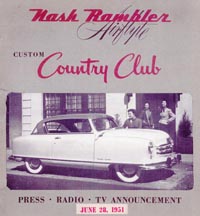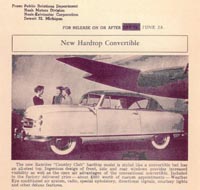FROM:
75grand.com Albany, NY
http://75grand.com
FOR IMMEDIATE
RELEASE
DUO
DRIVES 2000 MILES ROUND-TRIP TO ATTEND
THOUSAND
CAR SHOW IN KENOSHA, WI.
“KENOSHA
OR BUST: THE 20/20/20 TRIP”
ALBANY,
NY, July 28 - Joining 10,000 car enthusiasts and 1000 cars from around
the
USA
and the world, Ned Foss and Jan Galligan made a 60 hour odyssey in Foss’s
1951 Nash
Rambler
Custom Country Club to attend the 100th Anniversary Rambler celebration
in Kenosha, WI. The event was so popular that all 1000 hotel rooms in Kenosha
were booked
for
the event. “We had to send people to Milwaukee and Gurnee, Ill.” said Mary
Galligan,
president
of the Kenosha Area Convention & Visitors Bureau.
Foss,
an international businessman and real estate developer is based in Delmar,
NY.
Galligan,
of Albany, is an artist and documentarian with world-travel experience.
The
Nash centennial was marked by the introduction of the first mass produced
automobile,
the Rambler, built in 1902 by Jeffery Motors, which later became Nash Motors,
then
Nash-Kelvinator, then American Motors, which merged with Chrysler in 1987.
One year
later
Chrysler closed the Kenosha plant. Ironically, Charles Nash’s first partner
in Nash Motors
was
Walter Chrysler. Fortunately Kenosha bounced back, replacing the razed
lakefront
factories
with a new marina, condominiums and an automobile history museum as they
evolved
from a factory-town to a center for high technology.
Foss’s
Nash was described in a 1951 Nash Motors press-release as a trim and luxurious
sedan,
styled like a convertible and “offering distinguished modern styling, outstanding
performance, economy, comfort and ease of handling,” according to H.C.
Doss, vice president in charge of sales.
Taking
no chances on this cross-country marathon, Foss had his Nash Rambler
mechanically
overhauled and tested and then outfitted with the latest in roadway technology.
The
primary mechanical-electrical systems of the car were equipped with electronic
sensors
and
connected to a central harness for continuous real-time monitoring while
driving. The
harness
panel enables a laptop computer to be connected and systems data to be
fed into
“flight
command” software for instant analysis. Completing the loop, output from
the analysis software is displayed in one corner of the laptop’s screen
and simultaneously fed into an audio headset worn by the driver. The sounds
of the engine, running gear, milage and gas gauges are heard by the driver
as audible signals complete with warning reminders if the software senses
mechanical problems.
The
system allowed Foss to operate his business while Galligan was driving.
Using his
laptop
and a cell phone running DSL emulation, Foss was able to write memos, send
and
receive
email, upload reports, monitor the car’s location “to the foot, if necessary,”
and handle a continuous stream of international and conference telephone
calls, all while monitoring the car’s performance.
“With
this system in place, developed for me by a young hotshot in my office,
I felt
fairly
certain that we could make the trip without serious incident,” said Foss.
“And I can
proudly
say, we did,” he added. Along with the instant analysis the software also
provided
continuous
statistics on their progress: MPG, MPH, RPM, GPS, ETA, and cost per mile.
Galligan
said the trip was named ‘The 20/20/20 Trip’, “...because it was planned
for 20
hours
to get there, 20 hours to stay there and 20 hours to return.” “We were
only off by 10
minutes
on the final tally,” said Foss, “and that’s because Galligan lost something
at our
Cleveland
reststop and took the time to look for it.”
Galligan
generated comprehensive documentation of this ‘Nashional Ramble’ including
digital
color photographs, MPEG video, sound-clips and an hour-by-hour diary/log
which will
soon
be available on his website: http://75grand.com/20-20-20
Questions
or comments should be directed to: galligan@sprynet.com
- 30 - |
 |




|



